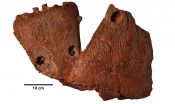(Press-News.org) A previously undiscovered species of crocodile-like amphibian that lived during the rise of dinosaurs was among Earth's top predators more than 200 million years ago, a study shows.
Palaeontologists identified the prehistoric species - which looked like giant salamanders - after excavating bones buried on the site of an ancient lake in southern Portugal.
The species was part of a wider group of primitive amphibians that were widespread at low latitudes 220-230 million years ago, the team says.
The creatures grew up to 2m in length and lived in lakes and rivers during the Late Triassic Period, living much like crocodiles do today and feeding mainly on fish, researchers say.
The species - Metoposaurus algarvensis - lived at the same time as the first dinosaurs began their dominance, which lasted for over 150 million years, the team says. These primitive amphibians formed part of the ancestral stock from which modern amphibians - such as frogs and newts - evolved, researchers say.
The species were distant relatives of the salamanders of today, the team says. The discovery reveals that this group of amphibians was more geographically diverse than previously thought.
The species is the first member of the group to be discovered in the Iberian Peninsula, the team says.
Fossil remains of species belonging to the group have been found in parts of modern day Africa, Europe, India and North America. Differences in the skull and jaw structure of the fossils found in Portugal revealed they belong to a separate species.
The new species was discovered in a large bed of bones where up to several hundred of the creatures may have died when the lake they inhabited dried up, researchers say. Only a fraction of the site - around 4 square meters - has been excavated so far, and the team is continuing work there in the hope of unearthing new fossils.
Most members the group of giant salamander-like amphibians was wiped out during a mass extinction 201 million years ago, long before the death of the dinosaurs. This marked the end of the Triassic Period, when the supercontinent of Pangea - which included all the world's present-day continents - began to break apart. The extinction wiped out many groups of vertebrates, such as big amphibians, paving the way for dinosaurs to become dominant.
The study, published in the Journal of Vertebrate Paleontology, was funded by the German Research Foundation and the National Science Foundation, the Jurassic Foundation, CNRS, Columbia University Climate Center and the Chevron Student Initiative Fund. Additional support was provided by the Municipality of Loulé, Camara Municipal de Silves and Junta de Freguesia de Salir in Portugal.
Dr Steve Brusatte, of the University of Edinburgh's School of GeoSciences, who led the study, said: "This new amphibian looks like something out of a bad monster movie. It was as long as a small car and had hundreds of sharp teeth in its big flat head, which kind of looks like a toilet seat when the jaws snap shut. It was the type of fierce predator that the very first dinosaurs had to put up with if they strayed too close to the water, long before the glory days of T. rex and Brachiosaurus."
Dr Richard Butler, of the School of Geography, Earth and Environmental Sciences at the University of Birmingham, said: "Most modern amphibians are pretty tiny and harmless. But back in the Triassic these giant predators would have made lakes and rivers pretty scary places to be."
Dr Steve Brusatte will discuss his work on recently discovered species and other aspects of palaeontology at a series of events at the Edinburgh International Science Festival, which runs from 4-19 April.
INFORMATION:
Suicidal patients who are under observation may be put at risk by relying on inexperienced staff and agency nurses, according to a new report issued today.
Commissioned by the Healthcare Quality Improvement Partnership as part of the Clinical Outcome Review Programmes, researchers from The University of Manchester's National Confidential Inquiry into Suicide and Homicide by People with Mental Illness, found that 18 in-patients a year died by suicide while under observation. This usually meant checks every 10-15 minutes but in 9% the patient was supposed to be under constant ...
Effective tuberculosis control in India needs political will and commitment, backed by sufficient resources, says a senior doctor in The BMJ this week.
Unless this happens, TB will continue to be India's silent epidemic and a death sentence for poor people, warns consultant physician and public health specialist, Zarir Udwadia.
Twenty years ago it was widely believed that India was successfully on its way to controlling its alarming tuberculosis (TB) epidemic. Yet, each year, India has 2.2 million new cases, more than 300,000 deaths, and economic losses of $23bn (£14.9bn; ...
Conscientious children are less likely to smoke in later life and the personality trait could help explain health inequalities, indicates a study published in the Journal of Epidemiology & Community Health.
It is well known that people belonging to lower socio-economic groups have lower life expectancy and more health problems than those who are in higher groups, and certain health behaviours, such as smoking, follow a similar pattern, suggesting they could be partly responsible for health inequalities.
Recently, certain personality traits have been found to be associated ...
At least 30 dogs in England have been killed in less than 18 months by an unknown disease which causes skin lesions and kidney failure, reveals research published in Veterinary Record.
The disease is believed to be Alabama rot (cutaneous and renal glomerular vasculopathy), a condition which has been seen in the USA in greyhounds for almost 30 years.
While there have been occasional reports of the disease in individual dogs outside of the USA, this is the first report of a series of cases occurring in England. None of the 30 dogs in this English series of cases were greyhounds ...
On May 19, 2014, the 67th World Health Assembly (WHA) adopted WHO's "Global strategy and targets for tuberculosis prevention, care and control after 2015". This post-2015 global tuberculosis strategy, labelled the End TB Strategy, was shaped during the past 2 years. A wide range of stakeholders--from ministries of health and national tuberculosis programmes to technical and scientific institutions, financial and development partners, civil society and health activists, non-governmental organisations, and the private sector--contributed to its development. The strategy has ...
Microbiological confirmation of childhood tuberculosis is rare because of the difficulty of collection of specimens, low sensitivity of smear microscopy, and poor access to culture. This study, led by Dr Anne Detjen, from the International Union Against Tuberculosis and Lung Disease, aimed to establish summary estimates for sensitivity and specificity of the Xpert MTB/RIF assay compared with microscopy in the diagnosis of pulmonary tuberculosis in children. The researchers found that compared with microscopy, Xpert offers better sensitivity for the diagnosis of pulmonary ...
1. Task Force finds insufficient evidence to recommend routine screening for thyroid dysfunction
The U.S. Preventive Services Task Force (USPSTF) concludes that the current evidence is insufficient to recommend for or against screening for thyroid dysfunction in nonpregnant, asymptomatic adults. The recommendations are published in Annals of Internal Medicine.
Thyroid gland disorders are among the most common endocrine conditions evaluated and treated by clinicians and may be asymptomatic. If left untreated, thyroid dysfunction could lead to fractures, cancer, or cardiovascular ...
Archaeologists working in Guatemala have unearthed new information about the Maya civilization's transition from a mobile, hunter-gatherer lifestyle to a sedentary way of life.
Led by University of Arizona archaeologists Takeshi Inomata and Daniela Triadan, the team's excavations of the ancient Maya lowlands site of Ceibal suggest that as the society transitioned from a heavy reliance on foraging to farming, mobile communities and settled groups co-existed and may have come together to collaborate on construction projects and participate in public ceremonies.
The findings, ...
CLEMSON, S.C. -- Researchers have long believed that supercomputers give universities a competitive edge in scientific research, but now they have some hard data showing it's true.
A Clemson University team found that universities with locally available supercomputers were more efficient in producing research in critical fields than universities that lacked supercomputers.
A supercomputer that can do 551 trillion calculations per second is housed at Clemson's Information Technology Center.
A supercomputer that can do 551 trillion calculations per second is housed at ...
DALLAS, March 23, 2015 -- Kids exposed to their parents' smoking may have a higher risk of developing heart disease in adulthood than those whose parents didn't smoke, according to research in the American Heart Association journal Circulation.
The study's results add to the growing evidence that exposure to smoking from parents has a lasting effect on children's cardiovascular health in adulthood.
Researchers tracked participants in the Cardiovascular Risk in Young Finns Study, which included childhood exposure to parental smoking in 1980 and 1983. They collected carotid ...


